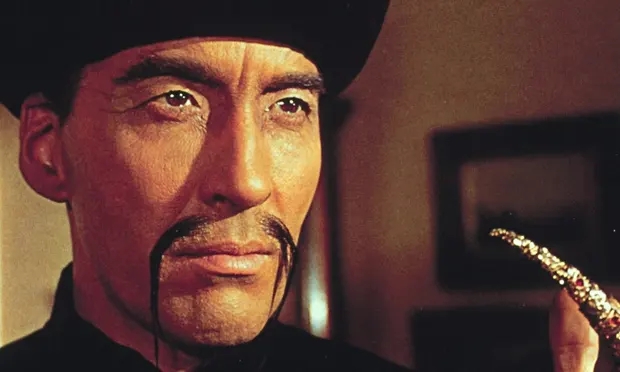The Fog and the Veil: The Hand of Fu-Manchu
by Mark Wallace
In my recent post of John Buchan’s fourth Richard Hannay novel, The Three Hostages (1924), I noted the wartime milieu of its predecessors had given way to an anxiety around foreign contamination. There was no outright war or threat of one, but the foreign Other was as threatening as ever, if in a more insidious way. I think I missed, however, an obvious influence on Buchan for this mood: the Fu-Manchu novels of Sax Rohmer, which had begun in 1914 with The Mystery of Dr. Fu-Manchu.

Christopher Lee in The Face of Fu Manchu 1965, from The Guardian.
The third instalment of Rohmer’s series is 1917’s The Hand of Fu-Manchu, and the London in which it is set is very reminiscent of that evoked by Buchan. London is perhaps the most memorable character in the novel. It is the London of Sherlock Holmes, a place of fog and veiled light, cut through by a dirty river hiding abominable secrets. From the opening paragraphs:
The window had been widely opened when I entered, and a faint fog haze hung in the apartment, seeming to veil the light of the shaded lamp.
The Hand of Fu-Manchu, Chapter I.
[…]
The long corridor without, lighted only by one inhospitable lamp at a remote end, showed choked and yellowed with this same fog so characteristic of London in November. But nothing moved to right nor left of me.
The fog, in quite a clever bit of foreshadowing, is yellow. Fu-Manchu is the symbol par excellence of the yellow peril – the idea that Chinese infiltration would lead to the downfall of Europe – and Rohmer suggests right at the beginning that the yellow peril is already here and all around, a miasma enveloping and choking London, waiting to be embodied in the fearsome figure of Fu-Manchu. The images of fog and veils recur throughout the book. In the opening chapter, Rohmer’s Holmes and Watson, Nayland Smith and Dr. Petrie, travel to see Sir Gregory Hale, a British diplomat who has traveled through deepest China and into Mongolia. He has some explosive secret and could be the savior of the Indian Empire–perhaps of all Western civilization.” He, in the closing words of the chapter, is “the man who has dared to raise the veil.” Sir Gregory possesses dangerous knowledge, though, and is not long for this world. He dies at the end of Chapter II, his room infiltrated by the same yellow fog:
There was no fog in the room, but already from the bleak corridor outside it was entering; murky, yellow clouds steaming in at the open door.
Chapter II
His final words, gasped out, include: “Yellow … rising.”
The other great natural presence in the book weighted with symbolism is the river Thames, “the river of many mysteries” (Chapter V). “the Thames, that gray old stream which has borne upon its bier many a poor victim of underground London.” (Chapter VII) One victim of Fu-Manchu is thrown into the river by that personage “as one might hurl a sack of rubbish” (Chapter XXII). The river is the grave of the poor, luckless and criminal, and its sides places of swarming activity, legal and otherwise. It is the Thames of Dickens’ Our Mutual Friend, dark and alluring, bounteous and deadly.
In a relatively unwonted piece of philosophising, the narrator Petrie says:
There is a distinct pleasure to be derived from a solitary walk through London, in the small hours of an April morning, provided one is so situated as to be capable of enjoying it.
Chapter XXXI
He goes on to explain that the policeman and the tramp, for example, are excluded from this pleasure because they have to be there, the policeman for work and the tramp for want of accommodation. They do not see or experience what the leisured gentleman does, “the solitude and mystery of the sleeping city”. This city of night and fog may be the most striking character in the novel, certainly more so than the anodyne English gentlemen who are the ostensible heroes.
Among the antagonists, however, a breath of life enters. As in The Three Hostages, in the feminine oriental a terrible and confusing mixture of the seduction and the repulsive enters, here in the form of Zarmi. Petrie is immediately “transfixed by the vindictive glare of … [the] huge dark eyes […] of this grotesque Oriental figure”. Her eyes, he remarks again, are “splendid, savage” (Chapter 3). The face is one of “devilish beauty” (Chapter XL). This ambivalence is key to this book as to Buchan’s; the Orient is terrible and immoral, yet alive in ways that the English characters cannot help but be drawn towards. Their moral compass insists on a categorisation of evil or wicked yet there is always an undercurrent of attraction towards this Other. That is where these books derive their life from. A century on, it is the dark side of London and the seductiveness of the imagined Orient in The Hand of Fu-Manchu that carry the reader through, not the cardboard heroes representing a flat, insipid England which one can hardly imagine standing up the dark intensity of Fu-Manchu.